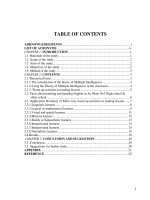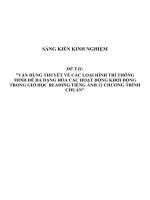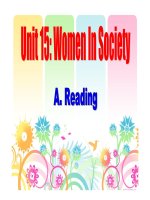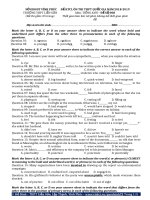READING PRACTICE/TIẾNG ANH 12
Bạn đang xem bản rút gọn của tài liệu. Xem và tải ngay bản đầy đủ của tài liệu tại đây (63.94 KB, 2 trang )
MORE READING PRACTICE /E 12 (UNIT 1, 2 & 3)
TOPIC 1: WAYS OF SOCIALIZING
Passage 1:
Nonverbal communication, or "body language", is communication by facial
expressions, head or eyes movements, hand signals, and body postures. It can be
just as important to understand -------(1)---- words are. Misunderstandings- often
amusing-----(2)-------- sometimes serious- can arise between people from
different cultures if they misinterpret nonverbal signals. For example, take the
differences in meaning of a gesture----(3)------- is very common in the United
States: a circle made with the thumb and index finger. To an American, it means
that everything-----(4)----- OK. To Japanese, it means that you are talking ---
(5)------- money. In France, it means that something is worthless. Meanwhile in
Greece, it is an obscene gesture. Therefore, an American could unknowingly
offend a Greek by using that particular hand signal.
46.A. as B. than C. more D. less
47.A. although B. but C. unless D. in order to
48.A. who B. where C. why D. that
49. A. is B. are C. were D. was
50.A. around B. about C. among D. ahead
Passage 2:
We can (1) __________other people in many different ways. We can talk and
write, and we can send messages with our hands and faces. There is also the
phone (including the mobile!), the fax, and e-mail. Television, film, painting,
and photography can also communicate ideas.
Animals have ways of (2) __________ information, too. Bees dance and tell
other bees where to find food. Elephants make sounds that humans can’t hear.
Whales sing songs. Monkeys use their faces to show anger and love. But this is
nothing (3) __________ to what people can do. We have language – about 6,000
languages, in fact. We can write poetry, tell jokes, make promises, explain,
persuade, tell the truth, or tell lies. And we have a sense of past and future, not
just present.
Radio, film, and television (4) __________ a huge influence on society in the
last hundred years. And now we have the Internet, which is infinite. But what is
this doing to this? We can give and get a lot of information very quickly. But
there is (5) __________ information that it is difficult to know what is important
and what isn’t. Modern media is changing our world every minute of every day.
1. A. communicate with B. talk with C. communicate to D. talk to
2. A. changing B. transferring C. exchanging D. giving
3. A. compare B. comparing C. is compared D. compared
4. A. have B. have had C. are having D. had
5. A. so much B. such much C. so many D. too much
TOPIC 2: HOMELIFE
The United States has many different types of families. While most American
families are traditional, (1)____ a father, mother and one or more children, 22
percent of all American families in 1980 were dead by one parent, usually a
woman. In a few families in the United States, there are no children. These
(2)____ couples may believe that they would not make good parents, they may
want freedom, the responsibilities of childrearing; or, perhaps they (3)_____
physically able to have children. Other families in the United States have one
adult who is a step parent. A step mother or step father is a person (4)____a
family by marrying a father or mother.
Americans tolerate and accept these different types of families. In the United
States, people have the right to (5)____ and Americans do not believe in telling
other Americans what types of family group they must belong to. They respect
each other's choices regarding family groups. Families are very important
(5)____ Americans.
1. A. Consisting of B. consisting C. Consist of D. In concluding
2. A. childlike B. childish C. childless D. childhood
3. A. weren't B. can't C. are not D. couldn't
4. A. who joins B. that leaves C. who leads D. which runs
5. A. respect B. change C. divorce D. privacy
TOPIC 1: CULTURAL DIVERSITY
Gift giving is important in Vietnam because of the significance of
interpersonal relationships in Vietnamese (1)______.
It is common in Vietnam for exchanging small gifts on certain occasions,
such as anniversary and Tet holiday, to (2) _____ your respect, appreciation or
gratitude.
Gift-giving customs depends on the context. If it is a private gift for one
Vietnamese partner you should give the gift (3)____ a private occasion or
private meeting. If you have a gift for the whole office or company, you should
give it after the business meeting with the whole office (4)_____.
Do not wrap a gift in black paper (5)____ this color is unlucky and
associated with funerals in Vietnam. Gifts that symbolize cutting such as
scissors, knives and other sharp objects should be advoided because they
(6)_____the cutting of the relationship.
The Vietnamese may or may not open these gifts when they are received;
leave the option to them. If you are offered a gift, you should ask the (7)____
whether you should open it when receiving or not. Regardless of when it is
opened or what it is, saying thanks are always (8)_____.
1. A. culture B. impression C. standard D. opportunity
2. A. feel B. express C. secure D. hold
3. A. on B. in C. for D. at
4. A. volunteers B. agencies C. staff D. work
5. A. although B. so C. and D. because
6. A. show B. develop C. mean D. guess
7. A. host B. giver C. receiver D. agent
8. A. formal B. friendly C. appropriate D. honest









